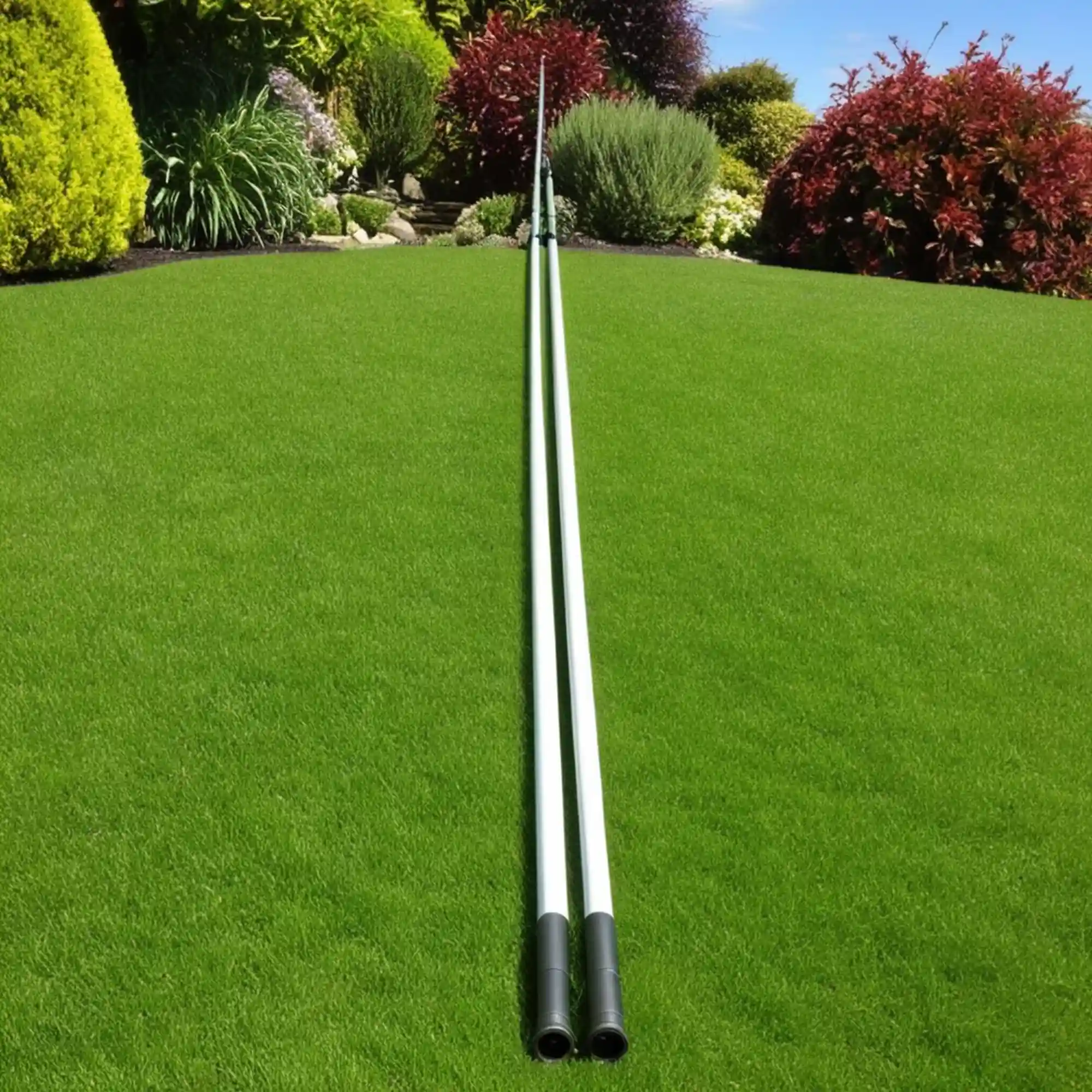What are Extension Poles and Why Do You Need Them?
As a gardener, you know how frustrating it can be to try to reach those hard-to-access areas of your garden. Whether it’s pruning a tall tree or cleaning a high window, it’s easy to strain your back and shoulders trying to stretch and contort yourself to get the job done. That’s where extension poles come in – a simple, yet effective tool that can make all the difference in your gardening experience.
But what exactly are extension poles, and why do you need them? In this article, we’ll take a closer look at the benefits of using extension poles, and explore the different types of poles available on the market.
Benefits of Using Extension Poles
So why should you use extension poles in your gardening routine? Here are just a few of the benefits:
- Increased reach: Extension poles allow you to reach high areas of your garden without having to use a ladder or strain your back and shoulders.
- Reduced strain: By using an extension pole, you can avoid putting unnecessary strain on your back and shoulders, reducing the risk of injury.
- Improved safety: Extension poles can help you avoid accidents and injuries by allowing you to work at a safe distance from the area you’re trying to reach.
- Increased efficiency: With an extension pole, you can complete tasks more quickly and efficiently, saving you time and effort.
Types of Extension Poles
There are several types of extension poles available on the market, each with its own unique benefits and drawbacks. Here are a few of the most common types of extension poles:
- Telescoping extension poles: These poles are made up of multiple sections that can be extended and retracted as needed.
- Fiberglass extension poles: These poles are made of lightweight, durable fiberglass and are often used for pruning and other tasks that require a high level of precision.
- Aluminum extension poles: These poles are made of strong, lightweight aluminum and are often used for tasks that require a high level of strength and durability.
- Steel extension poles: These poles are made of heavy-duty steel and are often used for tasks that require a high level of strength and durability.
Comparison of Extension Pole Materials
| Material | Weight | Durability | Cost |
| Fiberglass | Light | High | Medium |
| Aluminum | Medium | Medium | Low |
| Steel | Heavy | High | High |
As you can see, each type of extension pole has its own unique benefits and drawbacks. When choosing an extension pole, it’s essential to consider the specific needs of your gardening tasks and choose a pole that meets those needs.
How to Choose the Right Extension Pole for Your Needs
Choosing the right extension pole for your needs can be a daunting task, especially with so many options available on the market. Here are a few things to consider when selecting an extension pole:
- Length and reach: Consider the height of the areas you need to reach and choose an extension pole that can accommodate those needs.
- Material and durability: Consider the type of material you need for your extension pole and choose one that is durable and can withstand the demands of your gardening tasks.
- Weight and portability: Consider the weight and portability of the extension pole and choose one that is easy to maneuver and transport.
- Price and value: Consider the price and value of the extension pole and choose one that meets your needs and budget.
Top 10 Extension Poles for Gardening
Here are the top 10 extension poles for gardening, based on customer reviews and ratings:
- Fiberglass Extension Pole: This pole is made of lightweight, durable fiberglass and is perfect for pruning and other tasks that require a high level of precision.
- Aluminum Extension Pole: This pole is made of strong, lightweight aluminum and is perfect for tasks that require a high level of strength and durability.
- Steel Extension Pole: This pole is made of heavy-duty steel and is perfect for tasks that require a high level of strength and durability.
- Telescoping Extension Pole: This pole is made up of multiple sections that can be extended and retracted as needed, making it perfect for tasks that require a high level of flexibility.
- Extension Pole with Pruning Head: This pole comes with a pruning head attachment, making it perfect for pruning and other tasks that require a high level of precision.
- Extension Pole with Dusting Brush: This pole comes with a dusting brush attachment, making it perfect for dusting and cleaning high areas.
- Extension Pole with Squeegee: This pole comes with a squeegee attachment, making it perfect for cleaning windows and other surfaces.
- Extension Pole with Paint Roller: This pole comes with a paint roller attachment, making it perfect for painting and other tasks that require a high level of precision.
- Extension Pole with Hedge Trimmer: This pole comes with a hedge trimmer attachment, making it perfect for trimming and pruning hedges and other shrubs.
- Extension Pole with Ladder: This pole comes with a ladder attachment, making it perfect for tasks that require a high level of reach and stability.
Comparison of Top 10 Extension Poles
| Extension Pole | Material | Length | Weight | Price |
| Fiberglass Extension Pole | Fiberglass | 6-12 ft | 2-3 lbs | $20-$50 |
| Aluminum Extension Pole | Aluminum | 6-12 ft | 3-4 lbs | $30-$70 |
| Steel Extension Pole | Steel | 6-12 ft | 5-6 lbs | $50-$100 |
| Telescoping Extension Pole | Aluminum | 6-12 ft | 3-4 lbs | $30-$70 |
| Extension Pole with Pruning Head | Fiberglass | 6-12 ft | 2-3 lbs | $25-$60 |
| Extension Pole with Dusting Brush | Aluminum | 6-12 ft | 3-4 lbs | $30-$70 |
| Extension Pole with Squeegee | Fiberglass | 6-12 ft | 2-3 lbs | $25-$60 |
| Extension Pole with Paint Roller | Aluminum | 6-12 ft | 3-4 lbs | $30-$70 |
| Extension Pole with Hedge Trimmer | Steel | 6-12 ft | 5-6 lbs | $50-$100 |
| Extension Pole with Ladder | Aluminum | 6-12 ft | 3-4 lbs | $30-$70 |
How to Use Extension Poles Safely and Effectively
Using extension poles safely and effectively requires some knowledge and practice. Here are some tips to help you get the most out of your extension pole:
- Inspect the pole before use: Before using your extension pole, inspect it for any damage or wear and tear. Check for any cracks, dents, or broken parts.
- Use the pole at the correct angle: Use the extension pole at the correct angle to avoid straining your back and shoulders. Hold the pole at a 45-degree angle and keep your arms straight.
- Avoid overreaching: Avoid overreaching with the extension pole, as this can cause you to lose your balance and fall.
- Use the correct attachment: Use the correct attachment for the task at hand. For example, use a pruning head for pruning and a dusting brush for dusting.
- Keep the pole clean and dry: Keep the extension pole clean and dry to prevent damage and wear and tear.
Tips for Specific Tasks
Here are some tips for specific tasks that you can use your extension pole for:
- Pruning: Use a pruning head attachment and hold the pole at a 45-degree angle. Make sure to cut at a 45-degree angle to avoid damaging the plant.
- Dusting: Use a dusting brush attachment and hold the pole at a 45-degree angle. Make sure to dust in a circular motion to avoid missing any spots.
- Painting: Use a paint roller attachment and hold the pole at a 45-degree angle. Make sure to paint in a smooth, even motion to avoid streaks and drips.
- Cleaning windows: Use a squeegee attachment and hold the pole at a 45-degree angle. Make sure to clean the windows in a circular motion to avoid missing any spots.
Common Mistakes to Avoid
Here are some common mistakes to avoid when using an extension pole:
- Overreaching: Avoid overreaching with the extension pole, as this can cause you to lose your balance and fall.
- Using the wrong attachment: Avoid using the wrong attachment for the task at hand, as this can cause damage to the pole or the surface you are working on.
- Not inspecting the pole: Avoid not inspecting the pole before use, as this can cause you to miss any damage or wear and tear.
- Not using the pole at the correct angle: Avoid not using the pole at the correct angle, as this can cause you to strain your back and shoulders.
Conclusion
Using an extension pole can be a great way to reach high areas and complete tasks safely and effectively. By following the tips and guidelines outlined in this article, you can get the most out of your extension pole and avoid common mistakes. Remember to always inspect the pole before use, use the correct attachment, and hold the pole at the correct angle. With a little practice and patience, you can become a pro at using an extension pole.




